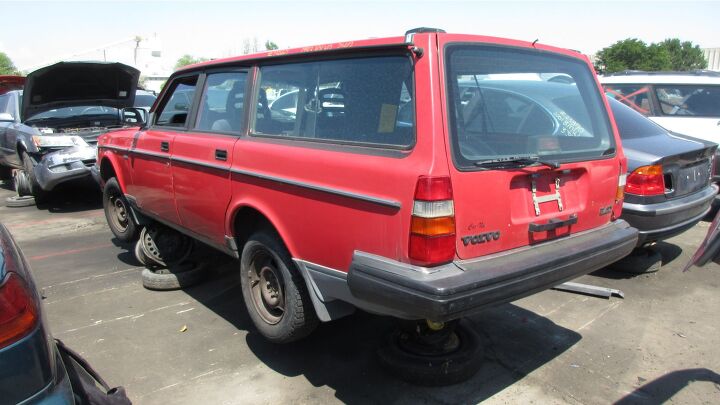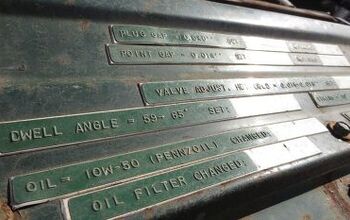Junkyard Find: 1993 Volvo 240 Wagon

Volvo made the beloved 240 for 19 model years, 1975 through 1993, and the car didn’t change much during that period. By the early 1990s, Volvo had “replaced” the increasingly dated-looking 240 three times, with the 740, 940, and 850, but plenty of buyers were still choosing the ancient brick over the more modern iron. It had to end at some point, though, and 1993 was the last year for these cars.
Here’s a very clean, very high-mile ’93 wagon in a Denver-area self-service yard.
In fact, the 240 was based on the even more ancient 140, being more or less the same car from the A pillars back, and much of the 140’s chassis design came from the antediluvian Amazon. You could say that the 1993 240 is based on designs from the 1950s or 1960s, and you wouldn’t be wrong.
Someone took very good care of this one over its lifetime, putting better than 12,000 miles on it every year over a quarter century. There’s no rust, the interior looks great, and the paint is less faded that what you’ll see on a lot of 10-year-old cars.
Changing the timing belt at 256,500 miles, because it’s due, shows the kind of dedication to maintenance you don’t see with most owners of older cars. Sure, it’s a non-interference engine and the timing belt may have been replaced after it broke, but I’m betting it was done because the maintenance schedule said so.
The final 240 had 114 horsepower from its 2.3-liter engine. These cars weighed a lot less than their bulky profiles might suggest; the 1993 wagon scaled in at just 3,051 pounds. That’s 150 fewer pounds than a 1993 Mustang GT.
Volvo got rid of the “245” name for these wagons after 1979.
I see many, many Volvo 240s in wrecking yards these days, but their numbers are decreasing.
Are you considering a minivan for your family? You might as well stuff your kids into a wood chipper!

Murilee Martin is the pen name of Phil Greden, a writer who has lived in Minnesota, California, Georgia and (now) Colorado. He has toiled at copywriting, technical writing, junkmail writing, fiction writing and now automotive writing. He has owned many terrible vehicles and some good ones. He spends a great deal of time in self-service junkyards. These days, he writes for publications including Autoweek, Autoblog, Hagerty, The Truth About Cars and Capital One.
More by Murilee Martin
Latest Car Reviews
Read moreLatest Product Reviews
Read moreRecent Comments
- IBx1 Everyone in the working class (if you’re not in the obscenely wealthy capital class and you perform work for money you’re working class) should unionize.
- Jrhurren Legend
- Ltcmgm78 Imagine the feeling of fulfillment he must have when he looks upon all the improvements to the Corvette over time!
- ToolGuy "The car is the eye in my head and I have never spared money on it, no less, it is not new and is over 30 years old."• Translation please?(Theories: written by AI; written by an engineer lol)
- Ltcmgm78 It depends on whether or not the union is a help or a hindrance to the manufacturer and workers. A union isn't needed if the manufacturer takes care of its workers.




















































Comments
Join the conversation
I owned an '83 240 sedan, and now own a '94 940. Both are excellent cars, though despite love and nostalgia to the contrary, the 940 is the better of the two, with many improvements over the 240. The engine pictured is not the 5 cylinder, but the venerable B230 red block, which I suspect is fully capable of doubling its mileage with no rebuild. While not perfect, these cars represent a high water mark for quality and long term durability seldom or never seen today.
I know this is an old post, but I had to share quick. I'm sitting here in our Volvo showroom and an older fellow just gave the thumbs up to his timing belt replaced for it's 2nd scheduled time. It was due back on 210k and he's up to 234k. Real world example, Volvo customers are amazing folks. This guy was just slacking in waiting an extra 2 years.